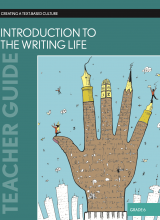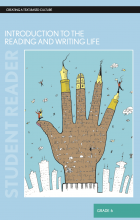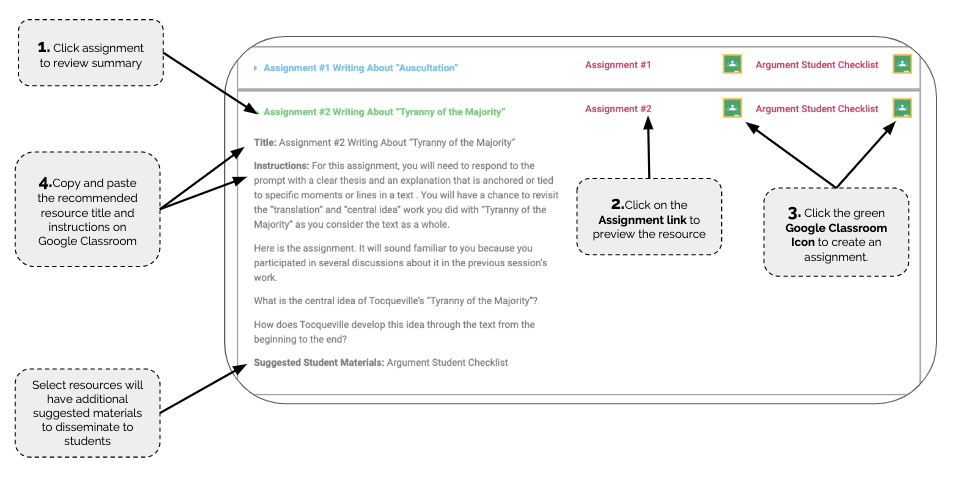Introduction to the Writing Life - Grade 6
During this unit, students will learn how to set up and maintain a writer’s notebook. The writer’s notebook is an essential writing tool. A place to remember, to think, to try new strategies and techniques, and to reflect on one’s own writing plans and progress, the notebook is the place where the work begins. It’s also a resource a writer returns to when she goes in search of new projects and new directions. The writer’s notebook is an essential part of a student’s writing apprenticeship.
This unit begins with the idea that if students are to become writers—that is individuals who see writing as a useful and productive way to spend, create, respond to, and process a life—they must be taught to live like writers. They must be introduced to the ways writers think, write, and read, and they must be introduced to the tools writers use to do their work.


Table of Contents
Writing Tasks
Title: The Writing Life: Self-Assessment
Teacher Manual Instructions:
Session 9
Display a copy of “The Writing Life: Self-Assessment” for the class to see and distribute copies to students. (Remember that the actual items on the self-assessment will be unique to your class and should closely reflect the four working charts created by your class .)
Review the self-assessment tool with the class and answer any questions students may have.
Give students the remainder of the work period to complete the self-assessment. Circulate among the class to assist with the goal statement portion of the assessment.
When students are finished, they should turn them in to you. After you have reviewed them, pass them back to the students and have them tape them into their notebooks so that they can monitor progress and review goal statements.
Charts for Discussion
Title: The Four Writing Charts
Teacher Manual Instructions:
Session 12
Post each of the four charts in the room (see “Materials” list above). Items will be added to the charts over the next several sessions.
Explain to the class that writers use their notebooks to think—that writing is, in fact, thinking. One of the most common types of thinking writers engage in is remembering.
Suggest to students that one of the things that distinguishes us as human beings is the need or compulsion to tell stories. Tell students that you want to tell them a story about an incident from your childhood. Explain that as you tell this story, you expect them to pay attention to the memories that pop into their brains. Alternately, you might consider sharing and drawing on stories from the StoryCorps Project, such as Marvin Goldstein’s story about falling out of a window when he was three years old. The StoryCorps website contains an archive of stories told by regular people about important moments in their lives. In addition to providing models to help students generate their own story ideas, the StoryCorps Project also offers a publishing outlet for the stories students craft and revise in the weeks ahead.
Tell your story or listen to a story from the StoryCorps website. Either way, be sure the story students hear does the things you want students to do in their own storytelling: describes scenes, names people and place, incorporates dialogue, etc.
Next, ask if anyone has a story that he or she wants to share with the class about something she or he has experienced. Call on someone who has followed the established procedures for whole-group discussion. You may have to wait a few moments for someone to volunteer.
After five or six students have shared, end the share time by explaining that these are the kinds of “remembering” thinking that often find their way into a writer’s notebook. Add students’ memory topics to the “Things Writers Write in a Notebook” chart (for example: “Memories about family vacations” or “Memories about birthday parties that went wrong”). Also point out that writing and speaking support one another—that oftentimes talking through one’s ideas helps a person get in position to write them down and that sharing something you have written and then talking about it with another person can help you see things about a piece that you might have otherwise overlooked.
Title: Rules for Timed Writing
Teacher Manual Instructions:
Session 2
Generate with the class the “rules” for timed writing. To do this, you might draw on a resource such as Natalie Goldberg’s chapter, “First Thoughts,” in her book Writing Down the Bones.
Keep your hand moving. (Don’t pause to reread the line you have just written. That’s stalling and trying to get control of what you’re saying.)
Don’t cross out or erase. (In other words, don’t edit as you write. Even if you write something you didn’t mean to write, leave it.)
Don’t worry about spelling, punctuation, or grammar. (Don’t even care about staying within the margins and lines on the page.)
Lose control.
Don’t think. Don’t get logical.
Go for the jugular. (Essentially, the idea is “embrace the hard stuff.” If something comes up in your writing that is scary or raw, dive right into it. It probably has lots of energy.)
Ask students to copy these “rules” down in their notebooks and update their table of contents.
Title: Show, Not Tell
Teacher Manual Instructions:
Session 7
Use 2-3 text excerpts (single paragraphs) to illustrate for students the concept of “show, not tell.”
Using display copies of these excerpts, ask students to help you identify moments in the text where the author is “showing.”
Work with the class to create a chart titled “Show, Not Tell” that provides clear examples of “showing” that students can review during class.
Title: Rubric for Scoring the Writer’s Notebook
Teacher Manual Instructions:
Session 9
Explain to students that today they are going to help you create a “rubric.”
Explain that a rubric is simply a scoring guide—a tool that helps a teacher and a student figure out where a student “is at” and also what that student needs to do to get to a better place.
On a chart, write the heading “Rubric for Scoring the Writer’s Notebook.” In Time for Meaning, Randy Bomer recommends that teachers use the following three criteria to evaluate the writer’s notebooks: volume, variety, and thoughtfulness. Set up the rubric so that it looks like the one nearby.
Note that although the criteria (volume, variety, thoughtfulness) are imported into the classroom, the rubric is not. For the rubric to be valid, students must collaborate with the teacher to develop the information that goes in the boxes.
Explain the rubric to the class—that when you look at a notebook to score it, you are looking for three things—volume (How many entries?); variety (How many different kinds of entries?); and evidence of thoughtfulness (Is this student taking this seriously?).
Ask students to look at the chart and think for a minute about how many (volume) entries a student should make per week to receive a “4” for volume.
Write that number in the box and work through the rest of the rubric with the class. When you get to “thoughtfulness,” your descriptors will shift from quantitative (numbers) to qualitative (words like “very thoughtful” and “shows some thought,” etc.). While this row is admittedly a bit more “fuzzy” than the other two, its power is found in its presence— that is, students know that you are looking for thoughtfulness, so they will learn to consider it in their note- book work.
Review the rules for independent writing time. Give students five to ten minutes to write in their notebooks.
Checks for Understanding
Title: Rules for Whole-Group Discussion
Teacher Manual Instructions:
Session 2
Reconvene the class and present the rules for whole-group discussion. Place the following items on a “Rules for Whole-Group Discussion” chart:
Raise your hand and wait to be called on before speaking.
Stay seated.
Listen to what other people have to say.
No put downs—be respectful of other people’s ideas.
Independent Reading
Title: Book Interview
Instructions:
Display a copy of the “Book Interview” for the class to see and distribute paper copies to students. (See example nearby or the Appendix for a copy-ready version.)
Using the book you just interviewed, show students how to fill out the sheet.
Pass out three books to each student.
Give students time to make an entry on their “Book Interview” sheet for each of the three titles.
Title: Books I’d Like to Read
Teacher Manual Instructions:
Organize students’ desks into one large circle, or two or three smaller circles.
Ask students to get out their notebooks.
Explain that the writer’s notebook will play an important role in their reading work and that writers often use their notebook to reflect on and track elements of their reading life as well.
Ask students to turn to the next blank page in their notebook.
Ask students to place the following heading at the top of that page: “Books I’d Like to Read.” Remind them to add this entry to the table of contents as well. Model this using your own notebook. Use the example above as a guide.
Explain that this page is the place where you write down books that you want to be sure to read. In short, it’s a remembering tool or a decision-making tool.
“Book Interview” forms students completed during the last session back to the class. Give students a moment to review these and, if they interviewed a book they think they might like to read, to enter it on the list.
Title: Book Pass
Teacher Manual Instructions:
• Explain the purpose of a book pass:
» A book pass is another way to expose students to the texts available to them in the classroom library. A book pass requires students to use their book interviewing skills. A book pass is a chance for students to find titles to add to their “Books I’d Like to Read” list.
Distribute copies of the “Book Pass” sheet to students. (A copy-ready version can be found in the Appendix.)
Be sure you have one title for each student in the circle.
Give each student one book (or magazine). Tell students it doesn’t matter what they start with, because they will see all the books.
Choose a direction for passing.
After students receive a book, they should immediately record the author’s name (if the text is a book) and title on the “Book Pass” sheet.
Give students one minute to interview each book following the procedure established in the previous session.
At the end of one minute, call “pass.” At this time, students should make an entry in the comments column and pass the book to the next student.
Continue the book pass until each student has interviewed all the books.
Title: Goals for My Reading Life
Teacher Manual Instructions:
Ask students to turn to the “Books I’d Like to Read” page in their notebooks.
Display a copy of “Goals for My Reading Life” for the class to see and distribute copies to students. Using the display copy, show students how to fill out the goals sheet. Show them how they can use the information charts created in earlier sessions to generate ideas for answers to the “Goals” questions.
Explain that at the beginning of each six weeks, each student will fill out
a new goals sheet. At the end of each six weeks, students will take a few minutes to review their goals statements and reflect on their efforts to meet them.Answer any questions students have about the “Goals for My Reading Life.”
Give students time to complete the sheet. (They should only fill out the goal-setting portion of the assessment at this point.) Tell them that these will be collected at the end of the closing meeting and that you will return these at the next session. (You may decide to photocopy a set for yourself.)
Return the sheets to students during the next session and have them attach the sheet to a page in their notebook.
Title: Reading Log
Teacher Manual Instructions:
Write “Reading Log” on the board.
Explain to the class that a reading log is simply a place where a reader keeps track of all the reading he or she has done over a period of time.
Ask students to turn to the next blank page in their notebooks and to reserve at least three pages for the reading log.
On a piece of chart paper or another display, show students how to set up a “Reading Log” in their writer’s notebook. (See example on next page.) They should be sure to enter it in their table of contents as well. You may decide to distribute sticky notes so that students can flag this page.
Explain to students that they should make an entry in their log only after they have finished a book. You will need to negotiate with students how to handle the entry of magazine readings (for example, entire issues versus individual articles).
After students have set up the log, including proper headings, creating the grid, etc., show students how to make an entry.
Answer any questions students have about the reading log.
Tell students that they can make their first entry in their reading log at the beginning of independent reading.
